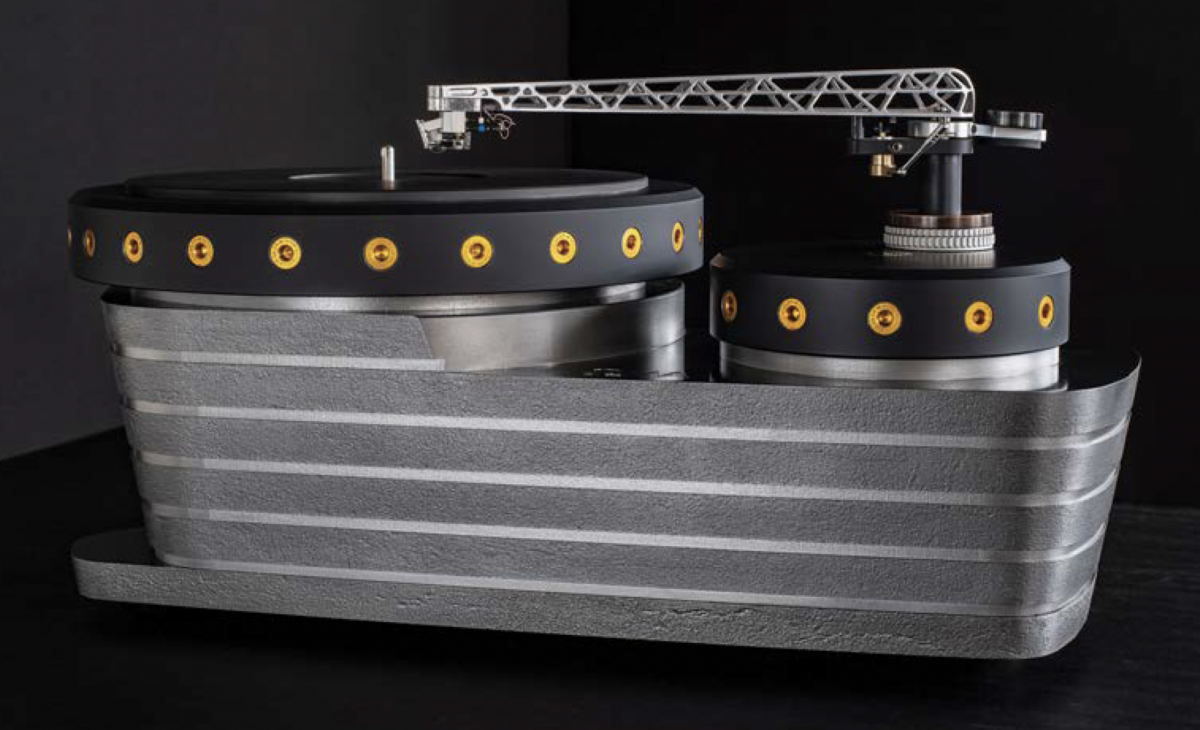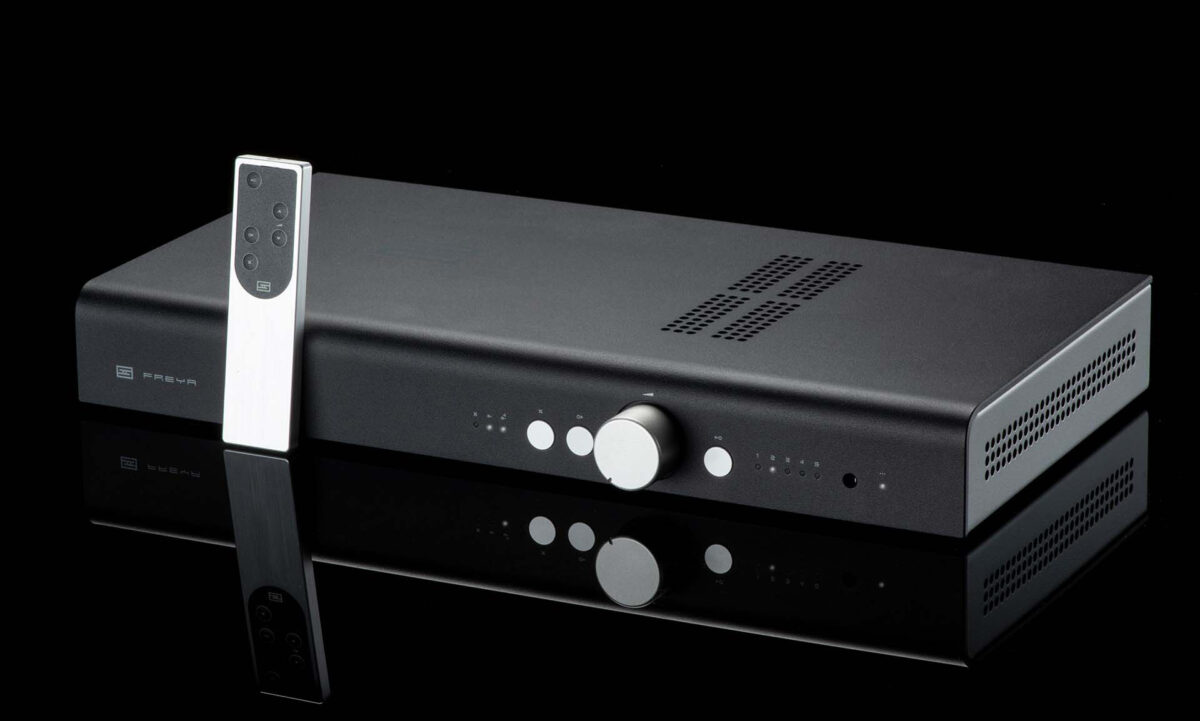
Attention audiophiles: If you win the lottery and conspicuous consumption is your goal, you really need another hobby. Should you suddenly find you’re rolling in it and want the world to know, you can buy a Lamborghini and drive slowly around the neighborhood. Or you can pick up a Patek Philippe Grand Complication Perpetual Tourbillon and wait for someone to ask for the time. Generally speaking, expensive audio equipment isn’t nearly as good a bet when it comes to “pride of ownership” (otherwise known as “showing off”). You just can’t take your new French monoblock tube amplifiers or four-box digital playback system out into the world, hoping to be noticed.
Even if a non-audiophile makes it to your listening room, an imposing pair of loudspeakers may go unremarked—a civilian may not even know what your MBL Radialstrahlers are, much less that they represent a pinnacle of music reproduction technology. (Oh, I think he might notice, Andy—JV.) The situation may be even more fraught with disappointment if the speakers are manufactured by the venerable Danish company, Audiovector, whose unassuming R3 Arreté floorstanders measure 7.5″ wide x 41″ tall (spiked) x 13″ deep, and weigh in at a paltry 53 pounds per side. To the untrained eye, they’re just…speakers. But attractive ones. The review pair was beautifully finished with a gorgeous redwood veneer, the grain appealingly matched, right and left. Their appearance will likely gain them admittance to a shared living space, even if the aesthetic keeper-of-the-gates is chronically suspicious of all things audio. In fact, the Audiovector product brochure goes so far as to state that the R3 Arreté’s “wife acceptance factor…ranks high.” Not exactly a “woke” comment in 2020, but probably true.
Ole Klifoth founded Audiovector in 1979 and continues to oversee R&D at the company. His son, Mads Klifoth, is Managing Director and CEO. Audiovector manufactures more than two-dozen loudspeakers—everything is made in Denmark—ranging from the economical QR series (the QR 1 bookshelf model is priced at $1500 per pair) all the way up to the flagship R11, which has an MSRP of $227,000. The company also offers on-wall and in-wall products, as well as speaker cables. At $9999 per pair, the R3 Arretés are positioned at the midpoint of the dealer price sheet.
The R3 Arreté is a 2.5-way design that has an AMT (air motion transformer) handling the uppermost portion of the frequency spectrum. This type of transducer was developed by Dr. Oskar Heil in the early 1970s. The diaphragm of a Heil driver is a pleated polyethylene membrane with the path conducting the audio signal bonded to it. This structure is suspended in a magnetic field and, when current is flowing, it moves like the bellows of an accordion to squeeze air out of the membrane’s pleats at a speed considerably faster than that at which the membrane itself is moving—the driver has the acoustic output of a much larger dynamic cone. Audiovector builds its own air motion transformers from scratch in-house, manufacturing several versions of the driver for different products. The R3 Arreté’s AMT has an “acoustic lens” that improves its dispersion characteristics and integration with the mid/bass drivers. Audiovector’s AMTs operate out to about 52kHz and function as dipoles, which may be unique for this kind of driver. This, Mads Klifoth explained, moves roll-off-related phase shifts well out of the audible range. Audiovector refers to the “Soundstage Enhancement Concept” in its marketing materials—the AMT fires backwards at a frequency range limited to 3kHz to 8kHz via two rear-facing ports at the top of the speaker, which benefits the R3’s spatiality.

The two dynamic drivers in the R3 Arreté look identical to each other and, indeed, both are 6.5″ cones with a membrane made of cross-woven Aramid fibers in a sandwich structure with an artificial wood resin. Voice-coil formers are made from titanium to minimize hysteresis effects. But the upper driver is designed to integrate with the light-on-its-feet AMT, while the lower one, equipped with a different magnet structure and voice coil, has a higher moving mass optimized for bass reproduction. The cones are made to Audiovector’s specifications by ScanSpeak, in Denmark; crossover points are specified as 2.9kHz and 320Hz, the latter between the two mid/bass units. Two sets of 5-way binding posts (to allow for bi-wiring) are mounted on a carbon-fiber plate, this material serving to eliminate unwanted electrical interactions with the nearby crossover elements.
Audiovector’s enclosures are fabricated from solid-core HDF, with substantial internal bracing. The R3’s cabinet is configured in a teardrop shape that, the company says, eliminates standing waves inside the box and obviates the need for a material like wool taking up valuable real estate within the box. Audiovector does employ broad-frequency Nano Pore damping plates that Mads Klifoth tells me are “strategically positioned and fixed to the cabinet.” Inside the cabinet are separate compartments for the two mid/bass drivers that communicate via an internal port. Klifoth maintained that this allows the two drivers to “control each other and play very loud without losing control.” The lower bass compartment is ported downward toward the floor through a “ventilated” plinth. That plinth—higher behind than in front—at first appears to be just an appealing design element, but actually helps to prevent a top-to-bottom standing wave inside the cabinet, as it’s not parallel with the R3’s top surface.
All of Audiovector’s speakers with the Arreté designation offer a proprietary technology the company calls the “Freedom Grounding Concept” that, according to Mads Klifoth, “eliminates motional feedback distortion in the baskets of the drive units.” This energy is routed away from the drivers through a separate grounding circuit and out of the R3 via a terminal found on the rear panel below the speaker-cable binding posts. Note that this is an entirely different electroacoustic design feature than the grounding terminal found on the back of a number of other loudspeakers—Tannoys are a well-known example—where the intent is to get RFI away from the voice coils. In the case of the Audiovector Arreté series speakers, two single cables, one from each loudspeaker, join together in a substantial Shunko connector that plugs into the wall. No power goes to the speakers, of course—the wall outlet connection is just a reliable ground. Each limb of the grounding cable that I was provided with was five meters in length, which would allow for the desired separation of right and left channels in any imaginable domestic listening space. The grounding circuit is standard with the R3 Arreté, but the cable is an additional $750. If you’re not interested in the Freedom Grounding feature, there are versions of the R3 that don’t have it.
Setup didn’t take long. The R3 Arretés worked well positioned near where other speakers of their approximate size had previously succeeded in my 225-square-foot room. They ended up 102″ apart, center-to-center, with the front baffles 112″ from the central listening position and slightly canted in. The backs of the speakers were 18″ from the front wall. The provided spikes didn’t make it through the not-especially-thick carpet and underlying acoustical pad to contact the concrete slab beneath. Purchasers encountering this problem can surely substitute longer spikes that will do the trick. For non-spikers, Audiovector supplies plastic feet that fit snugly into another set of threaded holes that accommodate the spikes. Grille covers, black fabric on plastic frames that are held in place magnetically, were removed for serious listening.
Components employed to test the R3 Arretés included a MusiCHI SRV-01 server or a Baetis Reference music computer to play digital files and an Oppo BDP-103, used as a disc transport. Control and D-to-A conversion were handled by either a T+A DAC 8 DSD or Anthem D2v. Mostly, power was provided by Pass Labs XA 60.8 monoblocks, though a pair of David Berning Quadrature Zs were substituted briefly to give the speakers a trial with tube amplification. To facilitate the assessment of the bi-wire option, either one or two sets of T+A Hex cables connected the amps to the Pass 60.8s. My Magico subwoofer saw some action, as below.
The Audiovector R3 Arretés sounded quite good right out of their boxes, and their character didn’t evolve appreciably over the weeks I listened to them. Mads Klifoth later told me that the speakers had been played for 50 to 70 hours before being shipped. With the R3s evidently at “steady state,” I wanted early on to address two questions anyone purchasing a pair will need to consider: Should the R3s be bi-wired, and should one spring for the $750 cable needed to activate the Freedom Grounding circuit?
With the robust jumper plate that connects the two pairs of binding posts removed, and with two sets of T+A speaker cables connecting the R3s to the Pass amps, there was better image focus and scaling of instruments than there was with just one cable. However, the effect of engaging the grounding system was qualitatively greater than the single-wire/bi-wire difference. Music was subjectively louder, as if background noise had been substantially reduced. With well-recorded rock/pop, snare and kick drum had more punch and impact; bass was cleaner. Accordingly, all my subsequent listening was with both the bi-wire and grounding options. In terms of the latter, Audiovector asks its dealers and distributors to do active A/B demos for prospective buyers, with and without the Freedom cable, and more than 95% of all R1 and R3 Arretés are sold with it.
High-frequency reproduction with the R3 Arretés is exceptionally open, extended, and non-fatiguing, thanks, no doubt, to the Heil tweeter. The nuances of the drummer’s cymbal work on Shelby Lynne’s “Just a Little Lovin” were exquisitely detailed; with choral recordings, sibilants were not nearly as distracting as they often are. One of my go-to musical selections for evaluating HF resolution is the Prelude to Act I of Wagner’s Lohengrin. It opens with the ethereal music associated with the redeeming knight himself, played softly by divisi violins at the top of their range; in a darkened theater, the effect is magical. Too often, with a recording, it can sound as if the pristine triadic harmonies have been generated by a synthesizer equipped with a VST plug-in to generate a violin-like sonority. Not so with the Audiovector R3 Arreté. Edo de Waart’s performance, ripped from an Exton SACD, provided a sense of multiple flesh-and-blood violinists playing unique instruments, intensely collaborating to produce Wagner’s otherworldly sonority. The “non-fatiguing” descriptor offered above should not imply that the highs are in any way dull, rolled-off, or otherwise attenuated. In fact, a visitor checking out the R3s in my system observed that the sound on one recording we auditioned was “bright,” and he was right. Audiovector’s AMT tells the truth and if there’s excessive high-frequency energy on a recording, you’ll know it.

The AMT driver, and its implementation here, also surely contributes to the superior spatiality and transparency of the sonic presentation with well-made symphonic recordings. On the recent account of The Sorcerer’s Apprentice from Pascal Rophé and the Orchestre National des Pays de la Loire—a BIS SACD, also available as a 24/96 download from eClassical—the orchestral textures have a see-through quality, with believable front-to-back layering and detail. This clarity is maintained as the volume level increases. The same can be said for Fabio Luisi’s reading of Richard Strauss’ Metamorphosen for 23 solo strings [Sony]. Played through the R3s, the intelligibility of all those independent lines, played by instruments having a similar sonority, is quite remarkable.
Timbral accuracy is unassailable. Make a playlist of the jazz and pop voices you like best—that’s what I did—and you’ll hear them represented with complete faithfulness to the recorded essence of their distinctive vocal instruments. Sinatra, Tormé, Billie, Ella, James Taylor, Rickie Lee Jones—every one had me hanging on his or her every word. The same goes for actual instruments. The Audiovectors readily differentiate Stradivarius from Guarneri, Telecaster from Stratocaster, trumpet from cornet from flugelhorn.
Bass is taut and tuneful and, especially if your room is cooperative, there can be surprising low-end extension—the open B string on the 5-string electric bass played on “Wrapped Around Your Finger” from Kevyn Lettau’s Songs of the Police, for example. However, with a pair of 6.5″ drivers, only one of which is fully dedicated to low-frequency reproduction, and an enclosure of this size, there simply can’t be the kind of prodigious output in the bottom octave that fans of Romantic pipe organ music or synth pop played at Studio 54 levels may require. The upside is the R3 Arretés won’t manufacture bass that isn’t there, and you’re less likely to overdrive a typical domestic listening space with less-than-musical results.
As a rule, it’s best to resist the temptation to add a subwoofer to a full-range loudspeaker in a small to medium-sized room—and the better that speaker is, the truer that maxim. As physicians are advised: “Primum non nocere”—”First, do no harm.” But it turns out that the Audiovector R3 Arreté may be a full-range speaker that’s particularly amenable to SW augmentation. It tried it with my Magico S-Sub, a powered design, in two configurations. First, I ran a set of analog cables from the T+A DAC to an Anthem line-level input, using the D2v’s volume control to adjust the sub’s output. Second, I used the Anthem for D-to-A conversion and its room correction/bass management software to determine how best to handle the signal. With the Audiovectors crossed over to the Magico at 60Hz, it was like listening to a much larger loudspeaker system, one that had the bottom-end authority needed for certain source material but that still manifested the transparency, speed, and tonal neutrality of the R3 Arretés by themselves. It may not work out that way with a so-so subwoofer. And even with the $15k S-Sub and sophisticated equalization, I still preferred listening to the Audiovectors on their own with 95% of the music I cared about.
The $10,000 per pair price point is getting to be a crowded space in the high-end loudspeaker marketplace. If this is your budget, there are quite a few candidates that will serve your music well, with strengths reflecting the best of what’s possible with the latest loudspeaker design developments and shortcomings that are generally subtractive, not what you’d call glaring deficiencies. Audiovector’s AMT driver, and all that derives from its implementation in the R3 Arreté, make this product one that deserves a very close listen. For many, so will the modest footprint of this supremely musical loudspeaker and the visual impression that it makes—or doesn’t make. If you end up owning them, you will indeed be a consumer of high-performance audio at the most exalted level. Albeit inconspicuously.
Specs & Pricing
Type: Floorstanding, 2.5-way, bass-reflex
Driver complement: Air Motion Transformer (AMT) tweeter, 2x 6.5″ bass/midrange
Frequency response: 23Hz – 53kHz
Impedance: 8 ohms
Sensitivity: 90.5dB
Dimensions: 7.5″ x 41″ (spiked) x 13″
Weight: 53 lbs.
Price: $9999 (Freedom Grounding Concept cable adds $750)
AUDIOVECTOR
Mileparken 22
DK-2740 Skovlunde
Denmark
audiovector.com
P.J Zornosa
Brand Manager USA
pj@audiovector.com
Tags: AUDIOVECTOR

By Andrew Quint
More articles from this editorRead Next From Review
See all
Oswalds Mill Audio K3 Turntable
- Apr 12, 2024

2023 Golden Ear: Schiit Freya S Preamplifier
- Apr 12, 2024




















